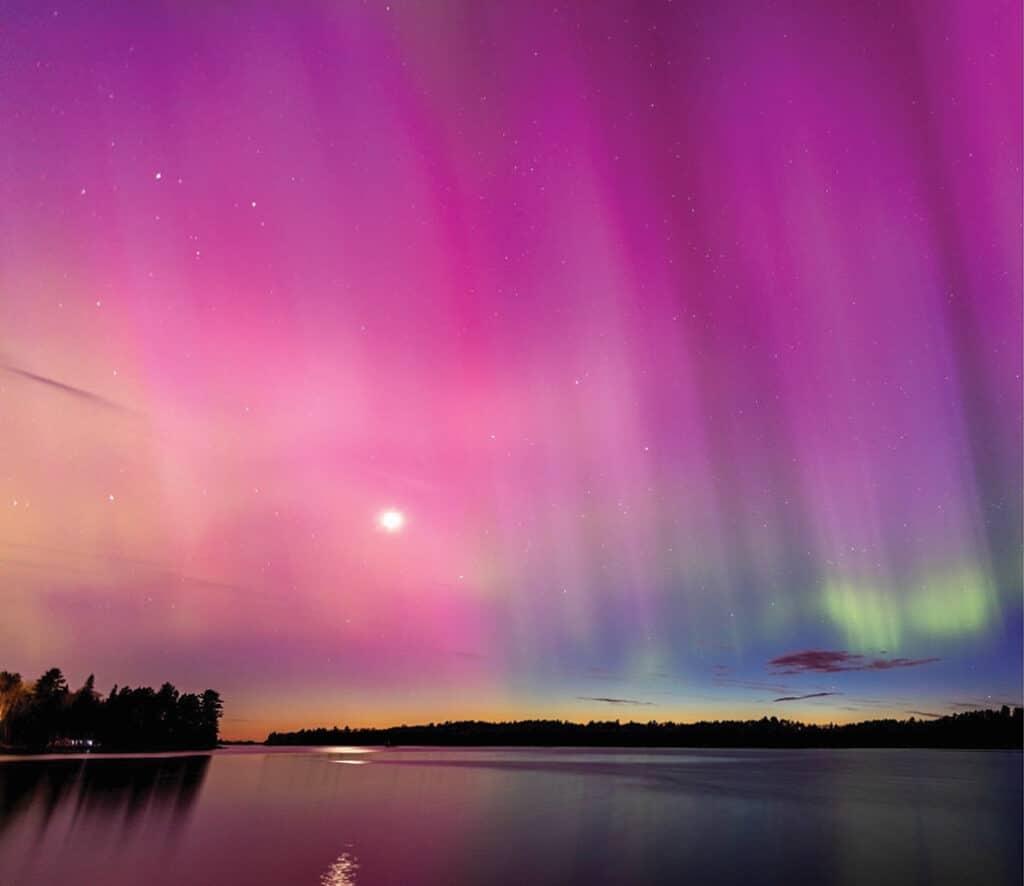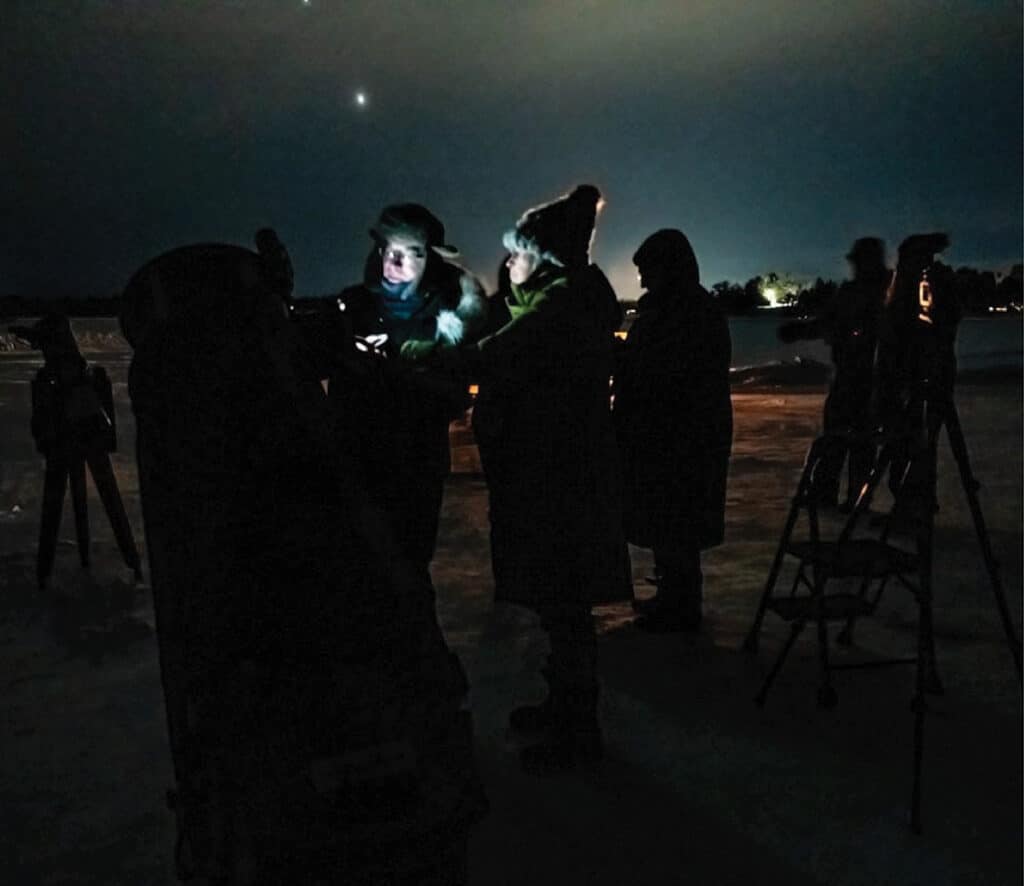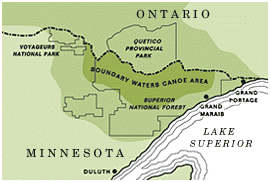
Experience some of Minnesota’s darkest skies during International Dark Sky Week, April 21-28. This weeklong initiative raises awareness about the importance of designating and preserving dark sky sanctuaries while also addressing the impacts of light pollution. Minnesota is home to two certified dark-sky parks. The Boundary Waters Canoe Area Wilderness (BWCAW) and Voyageurs National Park (VNP). Just across the border, Quetico Provincial Park has also received the same recognition. To celebrate, we’ve listed upcoming events and shared ways you can more deeply connect with the night sky.
Second largest dark sky sanctuary
Starry skies during a canoe or camping trip define the experience for visitors to places like the BWCAW, and witnessing the northern lights offers an unforgettable bonus. In 2020, officials recognized the BWCAW as the largest dark sky sanctuary in the world—a designation that underscores the ongoing need for stewardship and protection. Since then, it has become the second-largest, a title that shows other areas are adopting similar conservation practices.
DarkSky International, a nonprofit founded in 1988, awards these certifications globally to help safeguard areas from light pollution and raise awareness about the harmful effects of excessive light. Through public education and lighting policy initiatives, the nonprofit encourages communities, wilderness areas, and parks to actively reduce impact, highlighting that light pollution disturbs wildlife, uses up money and resources, affects the climate, and blots out our views. Light pollution also prevents the human eye from fully adapting to darkness. Additionally, they provide resources for responsible lighting products that individuals and communities can incorporate.
According to their mission, designations under consideration should be “public or private land that has an exceptional or distinguished quality of starry nights and a nocturnal environment that is protected for its scientific, natural, or educational value, its cultural heritage and/or public enjoyment.”
At the time, the BWCAW became the 13th park in the world to gain that title. Since then, DarkSky has certified 130 parks.
Ways to celebrate the night sky
We’re sharing several ways you can enjoy the night sky during Dark Sky Week—and all year long—as you venture north.
Located at the end of the Gunflint Trail, the Chik-Wauk Museum & Nature Center has installed an AllSky Camera on its roof to capture the sky each evening. The camera frequently records stunning views of the Milky Way and aurora borealis. In collaboration with the University of Minnesota Duluth and the Gunflint Trail Historical Society, the museum condenses each night’s footage into a time-lapse video. You can watch those updates daily on the Chik-Wauk AllSky Camera Facebook Page.
Whether you’re camping in the BWCAW or boating in the National Park, keep your eyes on the northern sky for brilliant displays of light. According to NASA scientists, the aurora borealis, known as the northern lights, are expected to peak through mid-2025. As these days grow longer, observers may need to stay up later to catch them dancing. Good viewing spots are often elevated—like hilltops—and located off the beaten path. Lakes are also excellent options, often providing wide, unobstructed views to the north. Cook County Visitors Center has compiled a Northern Lights Driving Route Map that lists locations and directions for seeing the aurora throughout the Arrowhead Region.
During Dark Sky Week, Voyageurs National Park will host ongoing events. Stop at Rainy Lake Visitors Center and peer through a telescope to view planets and other celestial wonders. Jesse Gates, a NASA Solar System Ambassador and Education Specialist with Voyageurs Conservancy, will describe what you see overhead, pointing out planets and constellations. Then, learn how the Park protects and advocates for its cosmic landscape.
Planning your dark sky adventure
Follow our handy guide to increase your chances of catching an unforgettable night sky. In the summer, you might need to stay up later or set an early alarm to catch the darkest skies—but it will be worth it! Remember to dress for the weather and bring a chair, as some displays like the aurora come and go over several hours.
- The night sky is best observed during a new moon. The week before or after a new moon is ideal. Check the Farmer’s Almanac calendar for the current moon phases.
- Use the compass on your smartphone to identify north.
- Find out when sunset occurs in your location. Remember, if you wake up on a clear night, get up and take a peek at the sky.
- Download the Aurora app for the best chance to view the northern lights. If the forecast predicts a good chance of seeing them in your area, set an alarm so you don’t miss the show.
- Carry a star chart or download SkyView Light. With SkyView, simply point your phone at the sky to identify stars, planets, constellations, and satellites.
- Use a red light to check your chart, camera, or phone, as it has less impact on your nighttime vision. Pick a headlamp that has this feature.
- Allow your eyes to adjust! This process can take up to 30 minutes.
- If you have the space, bring a telescope along.
- Check out this interactive map to find the darkest skies in Minnesota.
- Keep noise levels down so that others can quietly enjoy the views.

More info:
- DarkSky International
- 11 Dazzling Celestial Events to See in 2025, From a Total Lunar Eclipse to Rare Planetary Alignments – Smithsonian Magazine
- Learn about the Dark Sky – USFS-Superior National Forest
- Light Pollution – National Park Service

